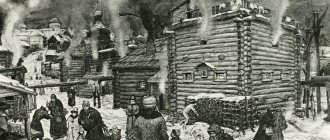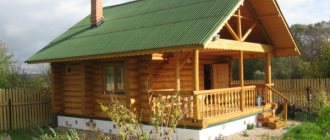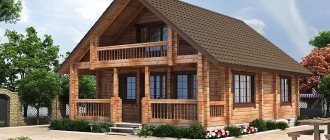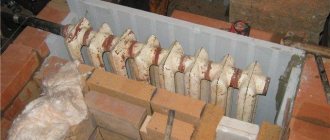A big warm greeting to all readers!
Today there are many types and designs of baths. Historically, the following types have developed - Roman, Eastern, Irish, Japanese, Finnish and of course Russian. Modern pundits distinguish the following types of baths and saunas:
- — Russian (high humidity bath);
- — Roman (dry with different temperatures in different rooms);
- — Sauna – Finnish bath (very hot with dry air).
With this division, Russian and Finnish baths are practically antipodes. In fact, the original Russian bathhouse was dry. A real village bathhouse is usually equipped with such a powerful stove that obtaining high-temperature dry steam is not difficult. There is also the following division of baths into types:
- Heater sauna (Russian or Finnish) with temperatures up to 120 degrees and humidity 5-20%;
- Steam, with a humidity of 75-100% and a temperature of 60-70 degrees;
- Water, according to the Japanese principle, with a temperature of 50-60 degrees.
To this division of baths by type, it is worth adding Turkish baths. Most likely, their prototype was one natural hot spring. The Russian and Finnish baths have a different origin - hot stones on which water splashed.
Classification of baths by microclimate
By and large, all baths can be divided into three main groups:
- Steam with minimal heating - characterized by soft heating up to +45-50⁰С and high humidity, which reaches 100%. In such a microclimate, the body does not experience overload; detoxification and cleansing occurs not due to high temperatures, but due to absolute humidity.
- Steam with medium heating - temperature within +50-60⁰С, with air humidity of 60-65%. At average temperatures and high humidity, a thin film of water from condensed steam forms on the skin, due to which the body warms up faster and deeper.
- Dry air - at temperatures of 100⁰С and above, humidity is minimal and is no more than 20%. High temperatures are necessary for deep heating, since dry air conducts heat worse than humid air. But many people tolerate elevated temperatures more easily than high humidity with average heating.
It is convenient that today there is no need to choose only one of the modes, since modern furnace equipment is universal and, if desired, you can get both hard dry burning and soft wet steam in the same bath.
Czech beer sauna
This innovation appeared in the Czech Republic about 9 years ago in the Chodovar brewery.
They say that visiting a beer steam room saturates the body with beneficial vitamins (beer contains a lot of vitamin B), and removes waste and toxins. The skin after this procedure is smooth and soft. The effect is noticeable for several weeks. According to some reports, bathing in beer can even protect a person from the evil eye. The essence of a beer bath is to heat the drink and mineral water in equal parts to a temperature of +37 degrees and fill the bath, which is traditionally presented in the form of an oak barrel. The duration of the session should not exceed 30 minutes. After the procedures, you need to wrap yourself up and sleep. It is not recommended to wash in water immediately.
Contraindications to visiting the beer steam room: changes in blood pressure, vascular inflammation, pregnancy, age under 12 years. It is undesirable to abuse alcoholic drinks while taking a bath.
Method of heating and steam generation
To bring the bathhouse to the specified temperature and humidity conditions, two main methods are used.
- Direct heating - closed, open or combined heater stoves are installed directly in the steam room, although some solid fuel models can be heated from an adjacent room. Steam is generated by the stone mass, to which water is periodically supplied.
- Distributed heat - pipes are built into the walls, floors and sun loungers, through which heated water circulates, heating the surfaces. In the original version, steam from water boiling in the boiler circulated through pipes laid in the floor, and it was supplied to the steam room through holes in the walls. In the modern version, the coolant is heated by an electric or gas boiler, and the humidity is provided by a specialized steam generator.
In both the first and second options, as it heats up, not only the equipment, but also the walls become a heat source, and additional heating occurs due to convection. To provide heat to the washing room, modern baths often have a water-heated floor.
When should you avoid taking a bath?
Despite the obvious benefits, visiting any bathhouse is contraindicated if:
- exacerbation of chronic diseases,
- acute infections,
- diseases of the cardiovascular system,
- diabetes mellitus and other metabolic disorders,
- pregnancy,
- drunkenness
You should not stay in the steam room for too long or forcefully: if you feel worse, you should immediately leave, avoiding sudden movements, and cool down. Special hats will help prevent excess overheating. Before the bath and during the procedure, you should not eat food - this will put extra strain on the cardiovascular system.
Features of the Russian bath
The original Russian bathhouse is a log house with a stove, in which they steamed, washed, and delivered babies from generation to generation. In the modern version, the steam room and washing room are separated, and the stove can be not only brick, but also metal (with or without brick/stone lining). In a Russian steam bath, the temperature regime is average and humidity is high: tanks with boiling water are no longer relevant; steam in the required quantity and quality is obtained from stones.
The air in the steam room is heated unevenly, which is quite convenient - those who prefer a lower temperature are located on the lower shelves, and those who prefer “hotter” temperatures are located on the upper ones, under the ceiling.
And, of course, what is a Russian bathhouse without a broom, thanks to which there are not two, but three heat sources.
p9181848FORUMHOUSE Member
In a Russian bath, in addition to radiation from the stove and walls and convection, a fundamentally different method, effect and pleasure is added: heat transfer by condensation of hot steam on the “cold” body of the steamer. This method (moving steam with brooms from the ceiling to the body) gives the speed of warming up and the main tactile pleasure, for those who understand and know how.
Egyptian sand bath
Its beneficial properties were known back in Ancient Egypt. According to the ancient Roman and Greek healers Pliny, Galen, Caelius and Herodotus, the sand steam room has a beneficial effect on human blood vessels and helps remove fat deposits.
Vertical sand bath
The essence of the procedures is as follows:
- We dig a hole in the sand the size of a person and, if necessary, clean it of large debris, algae, and stones. The sand used is fine and uniform.
- Let the sand in the pit warm up well in the sun. It should be hot at the bottom and walls.
- A person stands in this depression. We fill it with sand up to neck level.
- Cover the vacationer's head with a dry towel or umbrella to prevent heat stroke.
The duration of such a session ranges from five to twenty minutes.
Depending on the goals pursued and personal wishes, the sand bath provides additional procedures:
- During the session, a person is given watermelon to provoke increased sweating. This is recommended for people suffering from kidney stones.
- After the procedures, the vacationer wraps himself in a dry towel and drinks tea or broth to restore water balance.
- After the bath, a person bathes in sea or fresh water.
When the body is in the sand, it warms up evenly. The sweat released is also absorbed into the sand equally in all areas. Because of this, the vacationer does not feel discomfort, as with temperature changes.
Horizontal sand bath
Please note that visiting such a bathhouse has its contraindications.
These include anemia, general exhaustion and pneumonia. You can organize a kind of “steam room” as follows:
- We dig a pit 0.3-0.4 meters deep, its width and length depend on the height and weight of the vacationer.
- We leave it to warm up in the sun to +60-70 degrees.
- A man lies down in a hole. We fill it with sand to a level of 10-12 cm. At the same time, the layer of sand on the stomach should not exceed 3 cm, and leave the heart area open.
- Wrap your head in a damp towel or place an umbrella.
Session duration is up to 40 minutes.
After the procedures, you need to rest in the shade for 15-20 minutes and then take a shower. The main advantage of this type of steam room is that you can easily build a sand bath with your own hands. To do this, simply go to a beach with fine sand closer to noon, when the air temperature is high enough to warm up the hole to the required depth. If it is not possible to get to the beach, then you can use this service in spa salons.
A sand bath is an excellent alternative for people with fungal diseases for whom visiting a traditional steam room is not recommended.
Features of the Finnish sauna
Although there is an opinion that the Finns themselves are not at all opposed to giving in to the parka and waving a broom, the saunas that have spread throughout the world with their light hand are dry-air saunas. The humidity in them is minimal, the temperatures are extreme, and people steam mainly while sitting. The air warms up evenly and there is no such difference between the temperature on the bottom shelf and on the top, as in a Russian bath. Due to the sitting position, steam rooms are characterized by compact dimensions and a compact metal stove with an open heater. And since it is not necessary to pour water over the stones to create steam in saunas, the stoves can also be electric, which do not need to be heated, just set the appropriate mode. Saunas are often not separate buildings, but rooms directly in the house, since minimal humidity does not create any special problems when arranging a wall “pie”.
Whether in a bathhouse or a sauna, the effect depends not only on the microclimate in the steam room, but also on the “extras”.
p9181848FORUMHOUSE Member
The most important detail of a proper bath: a barrel, a font, or better yet, a pool, albeit a small one, for example, 150x200 cm, with a depth of 100 cm. After all, it is the consistent change in temperature when immersed in cold water that gives the main healing effect of the bath: temporary vigor; real euphoria (release of internal endorphins and serotonin); resulting long-term boost in immunity.
Infrared sauna: how does it work?
Infrared sauna
Special infrared emitters emit rays that barely heat the air in the sauna, but penetrate deep into your body and thus directly heat it. Air temperature is around 30-60°C . How it works?
- Due to the heating of body tissues, strong sweating occurs, and since the temperature in the cabin is low, this sauna method is more gentle on the body.
- If the infrared sauna uses high-quality heaters, then it is ready for use a second after it is turned on, that is, immediately.
- Conventional radiators heat up in a few minutes.
- This fact significantly affects energy intensity.
- Buying a cheap infrared sauna can become more expensive over time due to electricity bills.
The operating cycle in an infrared sauna can be extended to 20-45 minutes due to a more favorable temperature. After this, the body should recover and rest. The procedure should not be repeated, but you can use the sauna several times a week (but always once a day).
How does it affect the body? Explanation:
- An infrared sauna is suitable for those who do not like high temperatures in a Finnish steam room.
- The infra-steam room can be used by asthmatics, allergy sufferers or people with blood pressure above 140/100.
- If you play sports, this type of steam room is ideal before a sports performance. It warms up the muscles and improves their elasticity.
The infrasauna will perfectly help with joint pain, minor skin diseases, treats scars, eczema, acne. The special heat in this steam room relaxes the airways, improves skin elasticity and removes impurities. This works well if you also want to lose weight and as a cellulite preventative. Heat relaxes the airways and relieves fatigue, improving sleep.
Flaws:
- An infrared sauna is not suitable if you are being treated for a joint or infectious disease.
- Like the Finnish sauna, its use is not recommended for expectant mothers in the first trimester.
Visiting an infrared sauna is also not suitable for patients with hemophilia. Now let's compare several types of baths. Read on.
Features of the Turkish Hammam
A steam bath with minimal temperatures and absolute humidity is a Turkish hammam, although the Turks borrowed the idea from the Romans, but added a distinctive oriental flavor to the baths. If the Russian bathhouse and sauna are quite similar, and in one steam room you can enjoy both steam and dry air with alternating success, the hammam stands apart.
In a bathhouse/sauna, the air is first heated, giving off heat to the surfaces; in a hammam, on the contrary, the surfaces are heated (distributed heat), from which the air warms up.
And the surfaces themselves are not wooden, but exclusively stone and its derivatives, and this is due not only to the East’s craving for luxury, but also to the high thermal conductivity of the material. In its original form, the hammam includes a dressing room and five steam rooms with different temperature conditions, as well as several pools with warm and cold water. The version adapted by private owners differs from a regular bathhouse only in the specific steam room without a stove and in tiles.
Arrangement of thermal protection of walls and ceilings
Insulating the walls and ceiling of a bathhouse from the inside is similar to how it is done in other rooms, but special attention should be paid to the reliability of laying the vapor barrier layer. Stage one - creating the sheathing
The procedure for how to insulate the ceiling in a bathhouse from the inside suggests that the distance from the sheathing to the base of the wall or ceiling needs to be made slightly greater than the thickness of the material for thermal insulation
Stage one - creating the sheathing. The procedure for how to insulate the ceiling in a bathhouse from the inside suggests that the distance from the sheathing to the base of the wall or ceiling needs to be made slightly greater than the thickness of the material for thermal insulation.
When using galvanized profiles, this gap is adjusted using hangers, and the block is nailed down using a backing, which can be a piece of block. Galvanized hangers are also used for wooden sheathing.
The sequence for attaching the profile is as follows:
- A UD guide profile is fixed along the perimeter of the walls or ceiling, observing a 60-centimeter step. It is mounted to timber or logs with self-tapping screws, and to brick or concrete walls - with screws and plastic dowels.
- The axes of the CD profiles are marked, taking into account that the gap between them should allow the laying of heat insulation slabs without trimming. Then the hangers are attached to the wall, observing a step of 60-80 centimeters.
- To install and fix CD profiles to the hangers, use metal screws 9 millimeters long. The free edges of the hangers need to be folded.
Stage two - installation of insulation. Basalt wool in slabs is placed between the bars (profiles). The insulation of a ventilated façade or loggias is carried out in the same way. The work must be done in a respirator (gauze bandage) and special glasses. The fact is that the small fibers of this material are volatile and, when they get on the human mucosa, they greatly irritate it.
To cut the slabs, use a standard sharp knife. The insulation should not be crushed during installation. Regarding how best to insulate a bathhouse, you need to know that with a constant weight of the material, the smaller its volume, the worse its heat-insulating qualities will be.
Stage three – installation of steam and waterproofing. Strips of material are fixed horizontally from bottom to top, maintaining a 5-centimeter overlap. The foil side of the insulation should be facing inside the room.
The method of fixing the vapor barrier depends on the material from which the sheathing is made. So, before you insulate the steam room in a log bath, you need to stock up on a construction stapler. If there is a galvanized profile, the strips are secured with double-sided aluminum tape.
To create a high-quality vapor barrier, the insulation not only needs to be fixed, all existing joints must be taped with the same tape. Then moisture will not be able to penetrate the insulation.
Stage four – clapboard covering. To make the room cozy and beautiful after completion of insulation, it is necessary to finish the walls.
First, prepare the tools and materials necessary for the work, including:
- circular saw or electric jigsaw;
- drill - screwdriver;
- rasp (required when adjusting and processing the edge of the lining);
- construction square (necessary for marking boards);
- level and plumb line (they are in demand when checking verticals and horizontals);
- metal clamps for fixing wooden lining;
- copper or galvanized screws, which are needed for fastening the clamps to the bars;
- metal screws;
- wooden baseboards for finishing corners.
When carrying out work, you need to consider a number of points:
There should be a small gap between the lining and the vapor barrier layer. In addition, gaps (no more than 1-2 centimeters) are installed along the edges of the ceiling, as well as in the upper and lower parts of the walls.
The end boards in each row of the lining should be fastened with screws through and through, and their caps will be covered by the baseboard. All other boards will be held in place by clamps.
The above-described procedure for carrying out work allows you to both insulate an old bathhouse from the inside and a completely new building. Thermal protection of a bath structure is a very important stage, since the efficiency of the steam room depends on its quality. The main thing in the work is to take into account the slightest nuances and then the result will exceed expectations.
Bathhouse premises and their functionality
Even the smallest bathhouse should be divided into several rooms. This allows you to select separate zones with different functionality, maintain the required level of temperature and humidity in each of them, and make the use of all options comfortable and safe.
Traditionally, a bathhouse consists of:
- dressing room - prevents cold air from entering the room and warm air from leaving it. This is a mandatory element of construction. If it is not possible to equip a full-fledged vestibule, you can get by with a miniature nook with two doors opening in different directions. You can arrange a changing room in the dressing room - place small benches and a hanger so that you can leave clothes and change shoes. If the vestibule is combined with a rest room, then there may be a table, equipment for broadcasting video and audio, a grill and much more;
- washroom - a room separated by a door from the steam room. A comfortable temperature is maintained here. Washing in a hot steam room with a hot stove is difficult and unsafe. In addition, it is much more difficult to thoroughly warm a large room than an isolated space of 3-4 square meters. m. The size of the washing room depends on its purpose and the number of family members. If you plan to use it also as a laundry room, or you are going to bathe several children at the same time, you will need a spacious room. If the bathhouse is being built in a country house and is intended for meetings with friends, a shower in one of its corners will be enough, and half a square meter will be enough for this;
- The steam room is the main room - the “heart” of the Russian bath. It has no windows and is located as far as possible from the entrance. It contains a stove that heats the room. There are also shelves to accommodate people. They can be shortened - intended only for sitting and long. On horizontal beds you can steam, stretching out to your full height. If you need to make the most of a small space, you can install a cascading shelf structure on several “floors”.
How to correctly calculate the size of a steam room in a bathhouse
To correctly calculate the size of the steam room, you need to know approximately how many people will visit the steam room. In this case, if you have decided on the quantity, it will not be difficult for you to calculate the size of the steam room. For 1 visitor approximately 1 - 1.5 sq.m., for 2 visitors - 3 sq.m. and for 3 visitors, respectively - 5 sq.m.
Ease of use must also be taken into account. You need to steam while sitting, lying down, reclining. The area and height of the ceilings will be different:
- You can sit with your legs bent and steam with an area of 1-1.5 square meters, with a steam room height of 1.5 m.
- The most comfortable position in the steam room is lying down, but then you need to take into account that you will need a larger room. If you lie on a shelf with your legs bent, the minimum length of the shelf is 1.5 m and the dimensions of the steam room will be approximately 1.6 x 1.5 m.
- If you plan to equip a sun lounger, the length will increase to 1.7 - 1.8 m.
- You are planning a full-length sun lounger on a shelf with a length of approximately 1.9 m and a width of 0.6 m. For 1 visitor, the steam room area will increase to 2 sq.m.
- To optimally determine the height of the ceilings in the steam room, take the height of the tallest person who will visit the bathhouse.
To calculate the optimal size of the steam room, keep in mind that the shelves can be two-tiered, and people will steam in different positions, depending on how convenient it is. Therefore, consider that the dimensions of the steam room are approximately 5 - 8 sq.m., for 2 - 4 people.
Which material is preferable for lining a bath?
To equip the room reserved for the steam room, you should use lining made of coniferous and hardwood. In order to make the right choice, you should first familiarize yourself with the main characteristics of each type.
Abashi
Abashi-based lining is often found in bathhouses. The tropical representative has established itself as a practical material from which shelves are made that are practically not subject to heating. The tree comes from Africa, has a chocolate hue and a low density. Abashi darkens only after undergoing heat treatment, and before that the canvas has a white (sugar) or lemon-yellow color. There are no sharp tonal transitions, knots, pockets or other irregularities. As a decorative approach, sheets of untreated wood are alternated with treated ones, which allows you to create an original composition.
Hemlock
Also called Canadian hemlock. A representative of an evergreen plant that is often used in modern construction. It reaches maturity at 300 years of age, at which time it reaches a height of 50 m. It is similar in appearance to oak, for which it received its second name as American oak. The advantages of the material include a pleasant and light aroma of pine needles, a long service life, and increased strength and endurance.
Larch
This finishing material is distinguished not only by the original properties of the wood itself, such as high strength, elasticity, and specific gravity, but also by its excellent external characteristics. The sections reveal the unusual structure of the rock, which allows you to achieve an unusual effect and an interesting composition in the interior. Such material will never be cold, so it can please its owners for several years. The relevance of the use of the material is due to the presence of antioxidants in the structure of the material, which help cope with external factors. The cost of the cladding is high, which is not justified.
Cedar
This type of finishing material speaks of the high and refined taste of the owner of a bathhouse or sauna. Cedar lining will give the interior a unique style. The North American representative is the easiest to identify, as it has a reddish tint and an unusual aroma, which is considered medicinal for diseases associated with the heart and respiratory tract. The material is valued for its unusual structure, deep pinkish tone and unsurpassed aroma, which creates the necessary atmosphere in the room. It is characterized as a stable, durable material capable of disinfecting the air.
Alder
Alder lining, which is used in the manufacture of structures of high European quality, is also valuable. The black variety of alder, which is called royal wood due to its deep pink tone, is in demand. Practically does not require further processing, since knots are rare. The structure of the rock is resistant to various deformations, smooth, uniform. The material is not afraid of steam and moisture, which makes alder lining an indispensable assistant when arranging such premises as steam rooms in saunas and baths. There are different shades.
Aspen
The homogeneous and at the same time dense structure is considered a quality characteristic and is similar to linden. Aspen lining has a slight bitter aroma, which is due to the increased hardness of the material, which indicates a high service life of the product.
Before purchasing, you should pay attention to the absence of knots on the surface and the presence of resins, which is unacceptable, as it leads to difficulty breathing. Aspen lining is characterized as a high-quality material that undergoes careful sorting and selection
Linden
Linden lining is used as a finishing material for walls and floors. For a bathhouse, this type of material is considered the best way to decorate the premises. The structure of linden allows the surface to heat up quickly, the structure is soft, skin burns can be avoided due to its low thermal conductivity. Due to thermal conductivity, the material will slowly cool, which plays an important role in the case of baths or saunas. During the heating process, the material releases honey vapors, which emit a pleasant aroma. The essential oils contained have a beneficial effect on the body as a whole. The wood has excellent external characteristics and does not require additional processing.
Washing
The washroom is a very damp place. Therefore, experts recommend covering the walls, ceiling and floor with ceramic tiles or mosaics. Fortunately, there are tiles on the market that perfectly imitate wood structure. No? Do you want to enjoy the amazing beauty and sensual aroma of wood in every room of your bath or sauna? Well, what then? No problem.
You can decorate the washing room with the following types:
- luxurious teak;
- charming mahogany;
- noble abash.
These rocks are moisture resistant, but still require additional impregnation with special substances.
Luxurious teak
Teak, famous for its rich color palette, velvety surface and matte shine, is known for its excellent technical characteristics. For example, it is incredibly durable because it is biologically passive, chemically inert, moisture-resistant, and heat-resistant.
Due to the high content of certain natural oils, teak cladding has a beneficial effect on the human body. In addition, esotericists claim that the tree species has powerful energy. Teak is wonderful for covering all sink elements.
Charming mahogany
Mahogany is the wood of kings. She can't be demolished. She's not afraid of anything. This tree species is unaffected by climatic, chemical, thermal, mechanical and biological factors. In addition, it is incredibly beautiful and fragrant. Mahogany also has healing properties. In addition, it is famous for its light energy, which has a beneficial effect on a person. It is perfect for covering floors, ceilings and walls.
Dressing room and rest room
The following types of wood will fit perfectly into the dressing room and rest room:
- graceful birch;
- noble cedar;
- elegant linden;
- graceful pine;
- majestic larch.
What are these breeds good for? I'll explain now.
Graceful birch
Birch has long been valued by true bathhouse gourmets because it is beautiful, fragrant, healing and durable. Wood is soft, tough, elastic, but is afraid of moisture. In addition, it demonstrates anti-inflammatory, bactericidal, antifungal, strengthening, wound-healing, antiviral and antiseptic properties.
In addition, birch is an ancient amulet that protects against sorrows, sorrows, illnesses and enemies. It is perfect for finishing ceilings, walls and floors.
Noble cedar
Cedar is the favorite tree of avid bathhouse attendants because it is presentable, noble, and incredibly fragrant. It resists the harmful effects of climatic, mechanical, and biological factors. In addition, cedar has a calming, restorative, bactericidal, healing and anti-inflammatory effect.
In addition, according to esotericists, it cleanses the soul, enlightens thoughts and awakens the spiritual principle. Cedar is an ideal wood for lining the inside of a bathhouse.
Elegant linden
Our native linden
Linden is a tree that gently cares for the health of men, women and children, as it has analgesic, anti-inflammatory, protective, and rejuvenating properties. In addition, it is soft, light, hard, and also incredibly beautiful and fragrant.
Esotericists claim that wood has extremely powerful energy. Therefore, in a bathhouse or sauna with linden facing material, every person can quickly find peace of mind, getting rid of negative thoughts. Scented wood is excellent for finishing floors, ceilings, and walls.
graceful pine
Pine is the favorite tree of people who want to save money on building materials, but at the same time dream of purchasing high-quality raw materials. It is famous for its charming texture, exciting aroma, healing effect on the body, as well as good technical characteristics.
For example, pine is resistant to the destructive influence of mechanical, climatic and biological factors. In addition, it demonstrates antiseptic, disinfectant, anti-inflammatory, nourishing, and soothing properties. In addition, according to esotericists, pine is a tree of generosity, since it helps to forget all grievances, filling the soul and heart with joy and peace. It is ideal for finishing floors, ceilings and walls.
Majestic larch
Larch is a presentable tree, famous for its charming appearance, exciting aroma and first-class technical characteristics. For example, it is strong, flexible and hard. Larch resists the destructive effects of all negative factors.
In addition, wood releases substances that destroy all pathogens. Also, according to esotericists, larch has light and soft energy that eradicates fears, doubts, and anxiety. Wood is perfect for finishing all elements of the dressing room and relaxation room.











